JARS v64n3 - The Magnolias: Companion Plants for Rhododendrons
The Magnolias: Companion Plants for Rhododendrons
Peter Kendall
Portland, OregonAs a genus of plants magnificent in so many ways and ideally suited to northern temperate gardens, magnolias are star performers as companion plants for rhododendrons. Evolving during the Tertiary Period (65 to 2 million years ago), magnolias were among the first flowering plants (angiosperms) and at one time held sway over a vast portion of the northern temperate zones. Through changes in climate, particularly during the Pleistocene Ice Ages (2 million to 10,000 years ago), magnolia species number was decimated throughout Europe, much diminished in North America (surviving only in the east and the south), but flourished in Asia (particularly China and Japan) where the ravages of advancing ice were extremely limited.
The ornamental qualities of magnolias were first recognized in Asia centuries ago when Buddhist monks as early as the Tang dynasty (618-907 AD) introduced Magnolia denudata , the Chinese yulan or lily tree, to the premises of their monastic retreats. Regarded as a symbol of openness and purity, its elegant simplicity regaled its sittings. This magnolia was introduced to western European gardens by Sir Joseph Banks in 1780, making it the first temperate Asian magnolia species to be taken to Europe. It was, however, not widely grown there until well into the 19th century. I have always found it absolutely delightful and it occupies a primary niche in my limited one-tenth hectare (one-quarter acre) garden.
The greatest number of magnolia species is now found in China and Japan (e.g., M. kobus , M. stellata ), which harbor the earliest flowering and most northerly ones. Magnolias have a great number of inviting features. They thrive in any moderately friable soil with good drainage, tilth and a generous portion of organic matter. Sun or moderate shade is tolerated, and the ultimate size of most magnolias allows them to be considered for most gardens of modest proportion. They may also be readily pruned to accommodate a space that might otherwise prove untenable. Like tulips, the flowers of magnolias consist of tepals, as the sepals and petals are not differentiated. Magnolia flower colors range from white, pink, red, purple to chartreuse/yellow, and can be relatively small to among the largest in the plant world. The ensuing fruits are often colorful and intriguing in shape and disposition.

|
|
Magnolia campbelli
var.
alba
Photo by Peter Kendall |
Among the approximately 128 species magnolias, I make mention of only a very few (all of which are deciduous) to which I am most favorably inclined. As earlier alluded to, the ivory-colored M. denudata is at the top of my list. Its tepals appear early in the season (February to April) before emergence of the leaves and are a highlight of early spring. This species has the added bonus of flowering at a relatively young age (it is prolific at 3-4 years), and the blooms have a subtle lemon scent which is alluring at this time of year. M. campbelli , "the queen of magnolias," must be on anyone's desired list, but space and patience are required, as it may take close to 20 years for a plant to display its white or pink blooms. The English plant collector Frank Kingdon Ward (1930) provides a captivating picture of this plant and its surroundings in Sikkim:
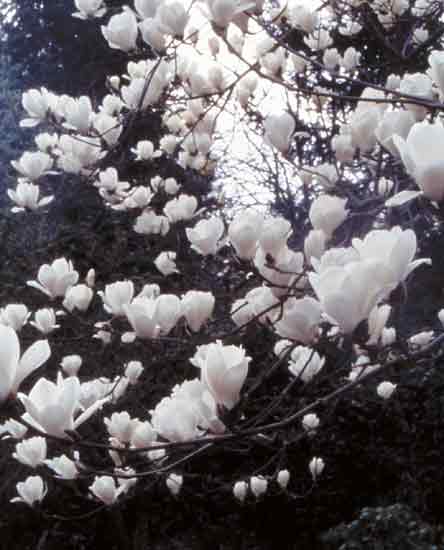
|
|
Magnolia
denudata
Photo by Peter Kendall |
"The road cleaves to the face of the cliff, winding round and round, ever ascending towards the distant snows, while the valley fades beneath us. At last the air grows colder, for it is only March, and we reach the zone of oaks and rhododendrons. Everything is padded in moss; long wisps of it swing from the branches of the trees. A thin mist floats ghostlike through the dripping forest. Suddenly round a corner we come on that first magnolia in full bloom. It is just below us and we look right into the heart of the tree, spouting with blossom. The site overwhelms us. After that we see scores of trees, some with glowing pink, others with ivory white flowers. From our giddy ledge we look down over the wide waves of the forest beating against the cliff, where the magnolia blooms toss like white horses, or lie like a fleet of pink water lilies riding at anchor in a green surf."
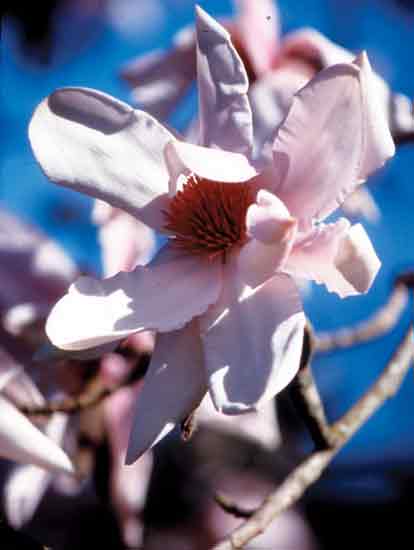
|
|
Magnolia
sargentiana
var.
robusta
Photo by Peter Kendall |
M. kobus and/or M. stellata , both with either white or pink tepals, are from Japan and are wonderful in particularly cold locales. M. stellata , the star-flowering magnolia, is an early and profligate bloomer, making it great in small gardens. M. liliflora nigra with its intensely dark pink to purple blooms is eye catching, while with its large leaves, nothing excels M. macrophylla from the southeastern U.S.A, with leaves up to 100 cm (40 inches) long and 46 cm (18 inches) wide, which are green above and a slivery, chalky white beneath. The flowers are commensurately large and white. M. sargentiana robusta from western Sichuan, China, is remarkable for the size of its tepals, which are up to 30 cm (12 inches) across and which range in color from pink to white. M. sprengeri var. sprengeri 'Diva', the "goddess magnolia," first grown by J.C. Williams of Caerhay's Castle in Cornwall from a batch of seed obtained from Veitch's closing down sale in 1913, is stunning for its deep wine-red flowers with rich pink tepals; it is a small to medium sized tree. M. wilsonii , named after Ernest "Chinese" Wilson, is one of my most prized selections. It belongs to the magnolia Section Oyama, which includes the similar M. sieboldii , M. sinensis and M. globosa , all from temperate east Asia. M. wilsonii is a moderately sized plant with pendant, cup shaped flowers borne during May and June. Its flower is ten cm (four inches) across with nine pure white tepal and a ring of rich rose stamens, and has a delightful fragrance.
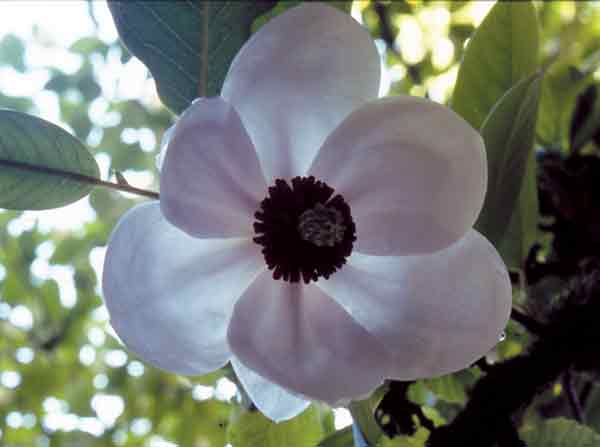
|
|
Magnolia
wilsonii
Photo by Peter Kendall |
Magnolia hybrids are many. A few that I prefer are M. 'Elizabeth' ( M. acuminata x M. denudata ) with creamy yellow flowers, M. 'Milky Way' (a M. soulangeana cross) with cup and saucer shaped white flowers during April that cover its branches, and M. 'Caerhay's Belle' ( M. sargentiana var. robusta x M. sprengeri var. sprengeri 'Diva') which produces magnificent pink flowers after about five years. I saw the original tree at Caerhay's Castle about eight years ago and it was astounding.
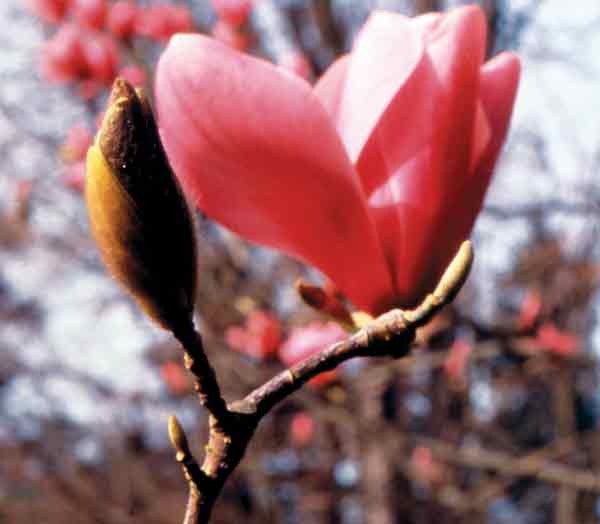
|
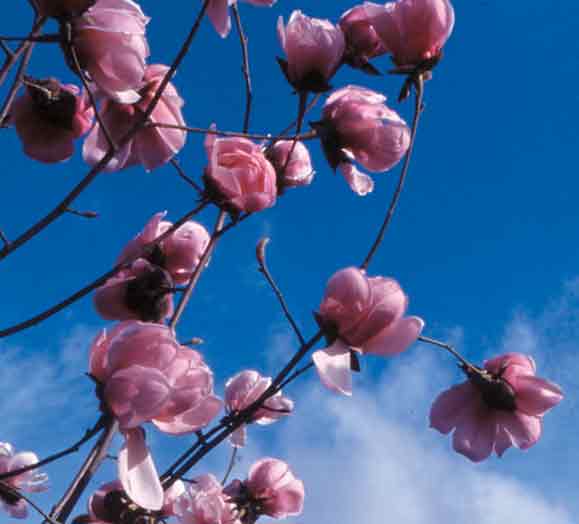
|
|
|
Magnolia
sprengeri
var.
springeri
'Diva'
Photo by Peter Kendall |
Magnolia 'Caerhay's
Belle'.
Photo by Peter Kendall |
A few of my special places for viewing magnolias are Cornwall in southwestern England, where the moderating influence of the Gulf Stream engenders trees without peer, and two gardens in Portland, OR, where I live, The Garden of the Bishop Close (formerly the "Peter Kerr Garden") and the Jane Kerr Platt Garden.
References
Gardiner, J. 2009. Magnolias, A Gardeners Guide . Timber Press, Portland, OR: 329 pp.
Kingdon Ward, F. 1930. Plant Hunting on the Edge of the World . Camelot Press, London: 384 pp.

Peter Kendall is a member of the Portland Chapter.
